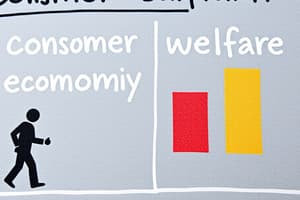Podcast
Questions and Answers
What does the concept of utility primarily measure in consumer welfare?
What does the concept of utility primarily measure in consumer welfare?
- Income distribution among consumers
- Market prices of goods
- Consumer happiness or satisfaction (correct)
- Consumer spending behavior
When a consumer's income is 120 and the prices of both goods x and y are equal to 1, what is the total initial consumption of both goods?
When a consumer's income is 120 and the prices of both goods x and y are equal to 1, what is the total initial consumption of both goods?
- 120 units of x and 0 units of y
- 80 units of x and 40 units of y
- 60 units of x and 60 units of y (correct)
- 30 units of x and 90 units of y
What change occurs in consumer welfare when the price of good x increases to 4?
What change occurs in consumer welfare when the price of good x increases to 4?
- The magnitude of change in consumer welfare cannot be determined without further information.
- Consumer welfare remains unaffected as utility is constant.
- Consumer welfare must increase because of higher prices.
- Consumer welfare decreases because it restricts the purchasing power. (correct)
In the context of the Cobb-Douglas utility function, what does the term 'indirect utility' refer to?
In the context of the Cobb-Douglas utility function, what does the term 'indirect utility' refer to?
What does the expenditure function describe in relation to the utility function?
What does the expenditure function describe in relation to the utility function?
What does Equivalent Variation primarily measure?
What does Equivalent Variation primarily measure?
In the provided example, what would the consumer need to lose in income to maintain utility level at the old prices after an increase in price?
In the provided example, what would the consumer need to lose in income to maintain utility level at the old prices after an increase in price?
How is Equivalent Variation calculated in terms of the expenditure function?
How is Equivalent Variation calculated in terms of the expenditure function?
When the price of a good increases, how does it affect the consumer's real income?
When the price of a good increases, how does it affect the consumer's real income?
What indirect utility function value was calculated when the price of good x was $4?
What indirect utility function value was calculated when the price of good x was $4?
What is the compensating variation in the given scenario when the initial income is 120?
What is the compensating variation in the given scenario when the initial income is 120?
How does equivalent variation differ from compensating variation in its application?
How does equivalent variation differ from compensating variation in its application?
What does the expenditure function E(1, 1, 30) represent in this context?
What does the expenditure function E(1, 1, 30) represent in this context?
What is a characteristic of a sales tax compared to an income tax?
What is a characteristic of a sales tax compared to an income tax?
How does compensating variation differ from equivalent variation?
How does compensating variation differ from equivalent variation?
What does the symbol τ represent in the context of a sales tax?
What does the symbol τ represent in the context of a sales tax?
Why might welfare analysis using sales tax be comparable to price increases?
Why might welfare analysis using sales tax be comparable to price increases?
If the price of good x increases from 1 to 4, and the consumer's utility falls from 60 to 30, what is the equivalent variation?
If the price of good x increases from 1 to 4, and the consumer's utility falls from 60 to 30, what is the equivalent variation?
What is the total cost of the bundle when px = 4 and py = 1 with quantities x = 30 and y = 120?
What is the total cost of the bundle when px = 4 and py = 1 with quantities x = 30 and y = 120?
To calculate compensating variation, which expenditure function values are compared?
To calculate compensating variation, which expenditure function values are compared?
In models that do not allow changes in income, how is an income tax characterized?
In models that do not allow changes in income, how is an income tax characterized?
What does the calculation E(4, 1, 60) provide in terms of consumer welfare?
What does the calculation E(4, 1, 60) provide in terms of consumer welfare?
When gas prices increase, what would compensating variation indicate?
When gas prices increase, what would compensating variation indicate?
According to the expenditure function, what would an income of 120 allow a consumer to achieve after the price of x increases?
According to the expenditure function, what would an income of 120 allow a consumer to achieve after the price of x increases?
What does Hicksian demand relate to in the context of consumer behavior?
What does Hicksian demand relate to in the context of consumer behavior?
Flashcards
Equivalent Variation (EV)
Equivalent Variation (EV)
The amount of income change that would make the consumer equally well off as they were before the price change, assuming they could adjust consumption to the new prices.
Compensating Variation (CV)
Compensating Variation (CV)
The amount of income change that would be needed to keep the consumer at their original utility level after a price change, assuming they can adjust consumption to the new prices.
What is the difference between Equivalent Variation and Compensating Variation?
What is the difference between Equivalent Variation and Compensating Variation?
EV measures the income needed to make the consumer as well-off as they were before the price change, while CV measures the income needed to keep the consumer at their original utility level after the price change.
How can we use consumer welfare measures in policy decisions?
How can we use consumer welfare measures in policy decisions?
Signup and view all the flashcards
What is the formula for the indirect utility function?
What is the formula for the indirect utility function?
Signup and view all the flashcards
Equivalent Variation
Equivalent Variation
Signup and view all the flashcards
Utility After Price Change
Utility After Price Change
Signup and view all the flashcards
Expenditure Function
Expenditure Function
Signup and view all the flashcards
Duality in Economics
Duality in Economics
Signup and view all the flashcards
Equivalence in Utility
Equivalence in Utility
Signup and view all the flashcards
Compensating Variation
Compensating Variation
Signup and view all the flashcards
How does Compensating Variation differ from Equivalent Variation?
How does Compensating Variation differ from Equivalent Variation?
Signup and view all the flashcards
What are the main applications of Compensating Variation and Equivalent Variation?
What are the main applications of Compensating Variation and Equivalent Variation?
Signup and view all the flashcards
Sales Tax
Sales Tax
Signup and view all the flashcards
How do sales taxes impact consumer behavior?
How do sales taxes impact consumer behavior?
Signup and view all the flashcards
What is the main difference between a sales tax and an income tax?
What is the main difference between a sales tax and an income tax?
Signup and view all the flashcards
Hicksian Demand
Hicksian Demand
Signup and view all the flashcards
Utility (U)
Utility (U)
Signup and view all the flashcards
How does Equivalent Variation help us understand consumer welfare?
How does Equivalent Variation help us understand consumer welfare?
Signup and view all the flashcards
What is the main difference between Equivalent Variation and Compensating Variation?
What is the main difference between Equivalent Variation and Compensating Variation?
Signup and view all the flashcards
How can Compensating Variation be used?
How can Compensating Variation be used?
Signup and view all the flashcards
Study Notes
Consumer Welfare and Taxes
-
Consumer welfare is analyzed using tools such as equivalent variation and compensating variation.
-
Equivalent variation (EV) measures the income change needed at old prices to achieve the same utility as after a price change.
-
Compensating variation (CV) measures the income change needed to maintain the same utility level as before a price change.
-
Calculations for both EV and CV use expenditure functions, holding prices constant.
- EV = E(p1x, p1y, Ū1) − E(p1x, p1y, Ū2)
- CV = E(p2x, p2y, Ū1) − E(p1x, p1y, Ū1)
-
Cobb-Douglas utility function U(x, y) = x1/2y1/2 is used as an example.
-
Initial income is $120, and prices for x and y are $1 each.
-
Initial consumption is x=60, y=60, utility is 60.
-
An increase in the price of x to $4 leads to a utility level of 30.
-
Equivalent variation is $60. This means the consumer would need a decrease in income of $60 to maintain the 60 utility level given the new price of x=$4.
-
Compensating variation (CV) - Expenditure at the new prices and the initial utility.
-
Income tax has a fixed amount. A sales tax is per unit.
Taxes
-
Sales Tax: a tax per unit purchased. The sales tax has no intrinsic difference from price changes.
-
Formula for after-tax price is pxt = px + T
-
Income Tax: a fixed amount deducted from the consumer's income.
-
Formula for after-tax income is It = I − T
-
Revenue generated by a tax will not always be enough to fully compensate for the loss in consumer welfare.
-
Income tax is less distortionary than sales tax because it does not affect the consumer's relative quantities, only the level of consumption.
Studying That Suits You
Use AI to generate personalized quizzes and flashcards to suit your learning preferences.




